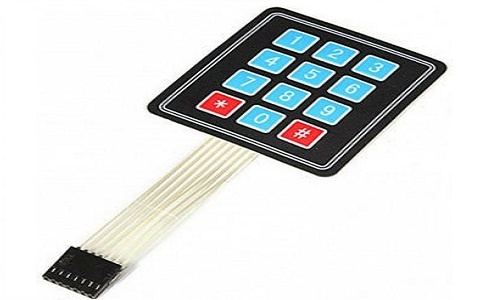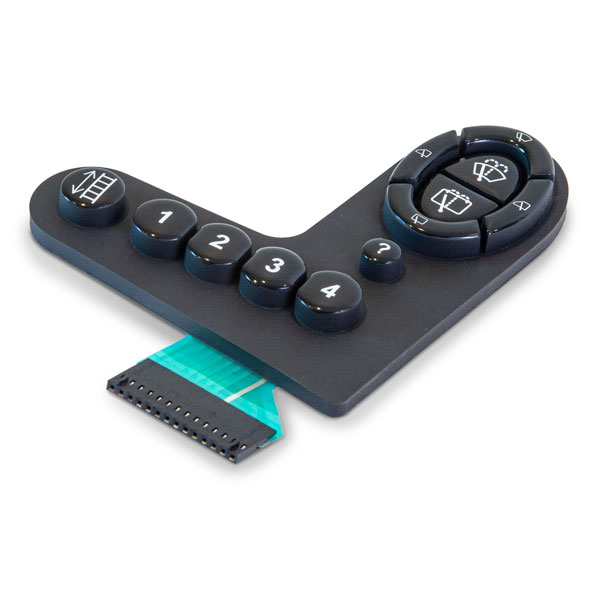All About Membrane layer Switch: A Comprehensive Guide for Beginners
Membrane layer buttons are important elements in modern electronic devices, providing an unique user interface for individual communication - membrane switch. Their layered building and construction, including overlays and conductive traces, provides functionality and resilience. Unlike traditional mechanical buttons, membrane buttons provide a smooth design and customizable choices. Understanding their key functions and advantages can change product layout. However, the ins and outs of their application and style factors to consider require additional exploration
What Is a Membrane Switch?
A membrane layer button is a sort of electric switch that includes an adaptable membrane layer layered over a published motherboard. This layout permits for a streamlined and portable interface, often made use of in different electronic tools. Membrane buttons are typically found in consumer home appliances, clinical equipment, and commercial equipment as a result of their toughness and resistance to environmental factors.The construction typically consists of multiple layers, such as visuals overlays and sticky support, which give tactile feedback and shield the circuitry below. The operation of a membrane layer button is initiated when pressure is put on the surface, completing an electric circuit.These switches are valued for their adaptability, allowing customized styles and published graphics that deal with particular customer interfaces. Their low-profile nature minimizes area needs, making them perfect for applications where typical switches might not fit. Overall, membrane switches provide a useful and aesthetic remedy for contemporary electronic devices.
Secret Parts of Membrane Layer Switches
Membrane layer changes make up several vital elements that contribute to their performance and efficiency. The top layer, known as the overlay, provides the customer interface and is frequently published with graphics or symbols. Beneath the overlay lies a spacer layer, which separates the conductive aspects and protects against unintended activation. The following crucial element is the graphic layer, which improves aesthetic appeals and guarantees the toughness of the design.Conductive traces, typically made from products like silver or carbon, are printed on the circuit layer. When pressure is put on the overlay, these traces enter get in touch with, finishing the circuit. In addition, a backing layer uses structural assistance and can be made from products such as polyester or polycarbonate. With each other, these components create a trusted, straightforward user interface appropriate for various applications, from house home appliances to commercial tools. Recognizing these elements is important for anyone interested in membrane switch technology.
How Membrane Layer Changes Work
Comprehending how membrane changes function is crucial for appreciating their widespread usage in various devices. A membrane layer button runs via a series of layers, consisting of a graphic overlay, spacer, and a circuit layer. When pressure is put on the overlay, it compresses the spacer layer, permitting the circuit layer to make call and complete an electric circuit. This activity sends out a signal to the device, prompting an action, such as switching on a light or triggering a function.Membrane changes can be designed with different functions, including tactile feedback, backlighting, and personalized graphics, improving customer interaction. Their building and construction enables a sealed design, protecting the interior parts from dust, wetness, and pollutants. This longevity makes them suitable for diverse applications, from customer electronics to commercial devices. In general, the simplicity and efficiency of membrane layer switches over add to their appeal in modern technology.
Advantages of Membrane Switches Mechanical Buttons
While mechanical switches have long been a staple in many gadgets, membrane layer switches offer unique benefits that make them significantly appealing. One substantial benefit is their slim profile, permitting even more small layouts and greater versatility in item advancement. Furthermore, membrane layer switches attribute a consistent surface area, which boosts aesthetic allure and streamlines cleaning, making them suitable for environments where health is critical.Another benefit is their resistance to dirt and dampness. Unlike mechanical buttons, which can be jeopardized by ecological variables, membrane buttons provide a covered user interface that protects versus contaminants - membrane switch. Furthermore, membrane layer switches generally have a longer life-span due to fewer relocating components, resulting in boosted durability and reliability.Cost-effectiveness is additionally a remarkable advantage, as membrane layer buttons can be generated in bulk with reduced manufacturing costs. These elements integrate to place membrane layer buttons as a sensible alternative to conventional mechanical choices in different applications
Usual Applications of Membrane Switches
Membrane layer buttons are widely made use of in various industries, especially in consumer electronics and commercial control panels. In customer tools, they provide a streamlined, user-friendly interface, while in industrial settings, they enhance durability and capability. Recognizing these applications highlights the convenience and practicality of membrane switches in modern innovation.
Customer Electronics Tools
As consumer electronics proceed to evolve, membrane switches have actually become a preferred selection for a variety of devices as a result of their convenience and streamlined layout. These buttons are frequently found in mobile phones, tablet computers, and remotes, where space is restricted and aesthetics issue. Their low profile and personalized layouts allow manufacturers to create user-friendly user interfaces that boost the general customer experience. Furthermore, membrane switches are frequently made use of in home appliances such as microwaves and coffee machine, giving instinctive control choices while standing up to wetness and dirt. The longevity and reliability of membrane changes make them appropriate for day-to-day consumer items, ensuring durability and regular efficiency. In general, their assimilation in customer electronics mirrors a mix of capability and modern style.
Industrial Control Panels
The applications of membrane layer switches over extend beyond customer electronic devices, discovering substantial use in commercial control panels. These buttons are preferred for their sturdiness and resistance to rough settings, making them ideal for manufacturing and procedure control settings. They supply a dependable interface for operators to manage machinery, monitor procedures, and readjust setups. Membrane layer switches can be customized to fit details functional needs, including features like backlighting and tactile feedback, improving individual experience. Their inconspicuous design enables assimilation into various equipment, while their capability to hold up against spills, dust, and severe temperature levels warranties durability. Overall, membrane layer buttons add to efficient and secure procedure in industrial applications, demonstrating their adaptability and efficiency sought after atmospheres.
Considerations for Designing Membrane Changes
When designing membrane layer switches, choosing the right products is crucial to guarantee longevity and functionality. Furthermore, understanding layer arrangement strategies can considerably affect the switch's efficiency and individual experience. These considerations play a crucial duty in producing trusted and reliable membrane switch designs.
Product Selection Relevance
Product option plays an important function in the style and performance of membrane layer switches. The selected materials straight affect the switch's toughness, tactile reaction, and overall aesthetic. Trick considerations consist of the substrate, which should provide structural honesty while enabling adaptability, and the graphic overlay, which requires to be immune to wear and ecological aspects. Conductive products need to ensure trustworthy electric efficiency, while adhesives should offer strong bonding without compromising the button's procedure. In addition, compatibility with producing procedures and end-user atmospheres is vital; products must hold up against differing temperatures, humidity levels, and chemical direct exposure. Inevitably, suitable product choice hop over to here not only boosts the membrane layer button's efficiency but also adds to its longevity and user complete satisfaction, making it an essential element of the style process.

Layer Configuration Techniques

Often Asked Questions
How Much Time Do Membrane Layer Switches Typically Last?
Membrane switches normally have a life expectancy of 1 to 5 million cycles, depending upon use and ecological problems. Elements such as style high quality and operating regularity considerably affect their longevity and general efficiency longevity.

Can Membrane Switches Be Custom-made for Specific Styles?
Membrane layer buttons can indeed be tailored to accommodate certain designs, enabling diverse forms, colors, and performances. This flexibility allows producers to customize these switches to fulfill one-of-a-kind visual and operational requirements properly.
What Materials Are Made Use Of in Membrane Switch Building?
Membrane buttons are usually built utilizing products such as polyester, polycarbonate, and adhesive layers. These products offer resistance, versatility, and longevity to environmental factors, ensuring the buttons function properly in numerous applications and conditions.
Are Membrane Layer Switches Over Resistant or waterproof to Moisture?
Membrane switches can be designed to be moisture-resistant, making use of specialized layers and products. However, their water resistant abilities depend upon construction top quality and particular applications, making it important to examine demands for perfect efficiency in different environments.
Just How Are Membrane Changes Fixed if Damaged?
Repairing broken membrane switches usually involves changing the influenced layer or circuit. Professionals might additionally apply conductive adhesive or make use of specialized repair packages, making certain performance is recovered without total replacement of the entire switch assembly. Unlike conventional mechanical switches, best site membrane switches present a streamlined layout and adjustable options. A membrane layer switch is a kind of electrical switch that consists of a versatile membrane layered over a printed circuit board. The procedure of a membrane layer switch is launched when stress is used to the surface, finishing an electric circuit.These buttons are valued for their adaptability, allowing personalized layouts and printed graphics that provide to particular user interfaces. While mechanical switches have long been a staple in several gadgets, membrane layer switches deal distinctive benefits that make them increasingly appealing. Membrane buttons commonly have a longer life expectancy due to fewer moving components, resulting in enhanced longevity and reliability.Cost-effectiveness is additionally a remarkable benefit, as membrane buttons can be produced in mass with lower manufacturing expenses.